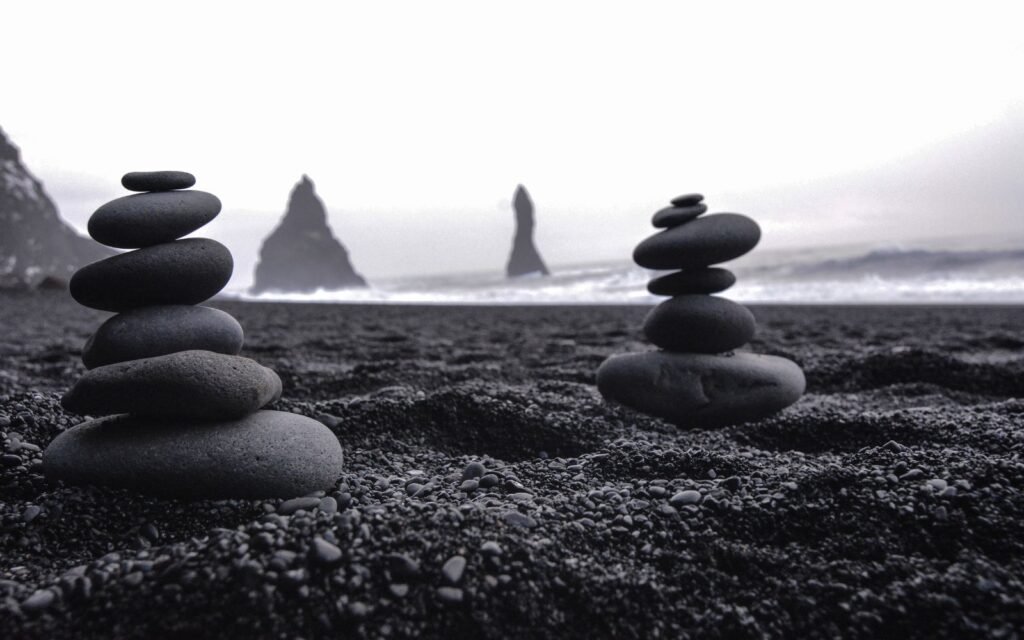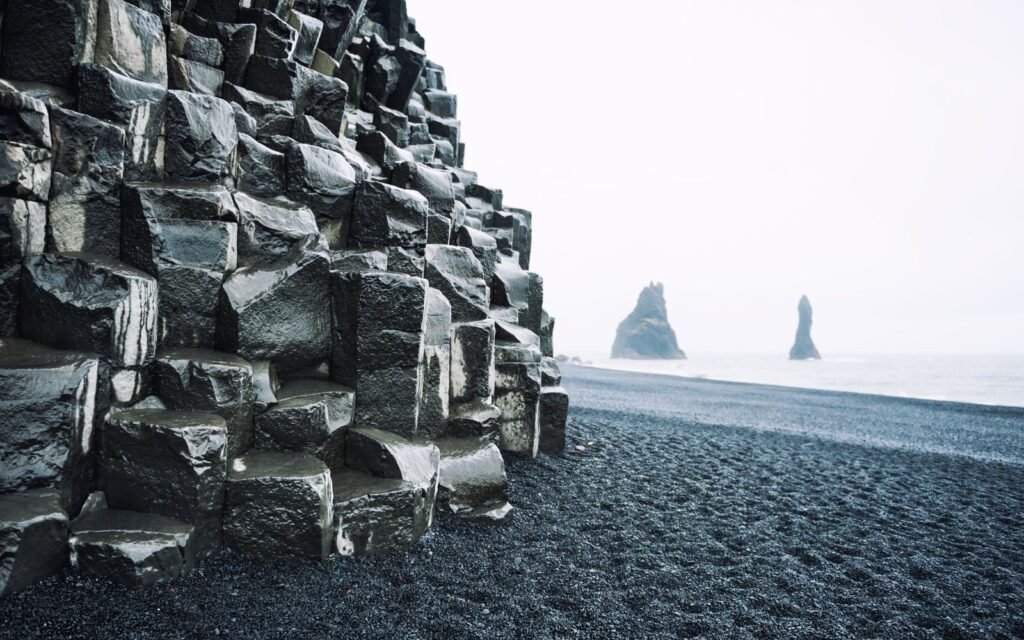Most travelers to Iceland are captivated by the unique and mysterious allure of its black sand beaches. The stark contrast of the obsidian sands against the dramatic backdrop of the North Atlantic Ocean creates breathtaking photo opportunities. In this guide, we will investigate into the necessary tips and techniques to help you successfully capture the unforgettable beauty of Iceland’s black sand beaches.

From mastering the play of light and shadows to understanding the best angles for that perfect shot, this comprehensive guide will empower you to transform your photographs into masterpieces. Venture with us and let’s unlock the secrets to capturing the magic of Iceland’s black sand beauty.
Key Takeaways:
- Research the best time to visit: Visit Iceland’s black sand beaches during low tide to capture stunning images with rock formations and crashing waves.
- Use a tripod for stability: Capture sharp and detailed images by using a tripod to keep your camera steady, especially in windy conditions commonly found on these beaches.
- Experiment with composition: Get creative with your compositions by including elements like volcanic rocks, sea stacks, and unique lighting conditions to add interest and depth to your photos.
Discover the incredible landscapes of Iceland and walk along a black sand beach.
Preparing for Your Photography Trip
Essential Equipment for Beach Photography
Even though capturing the beauty of Iceland’s black sand beaches can be a rewarding experience, it’s crucial to have the right equipment to ensure you get the best shots possible. Some vital items to pack include a sturdy tripod to keep your camera stable in windy conditions, a wide-angle lens to capture the vast landscapes, and ND filters to control the intense light often found on the beach.
Understanding the Right Time to Visit
Even though Iceland’s black sand beaches are stunning year-round, understanding the right time to visit can make a significant difference in the quality of your photos. While the summer months offer long daylight hours and milder weather, the winter months provide a chance to capture the beaches covered in snow and ice. Another important detail to note is that the weather in Iceland can change rapidly, so be prepared for sudden storms or fog rolling in.
Discover Iceland’s South Coast – Black Sand Beaches and take stunning photographs a lifetime memories.
Composition and Techniques
Now, if you are planning to visit Iceland’s Reynisfjara Black Sand Beach, be sure to check out How to Get to Iceland’s Reynisfjara Black Sand Beach article for detailed directions and tips on making the most of your trip.
Composing Your Shots with Natural Contrast
On Reynisfjara Black Sand Beach, the striking contrast between the black volcanic sand and the white crashing waves against the basalt rock formations provides a unique opportunity for captivating compositions. To enhance your shots, consider framing your subjects against this natural contrast to create visually stunning images.
Long Exposure Tips for Capturing Waves
Natural wonder of the black sand beach is the powerful waves crashing against the shore. To capture the dynamic movement of the waves, utilizing long exposure photography techniques can result in mesmerizing images. Setting up a tripod and using a slower shutter speed can help you achieve that smooth, ethereal effect on the waves.
- Position yourself strategically to get the best angle
- Experiment with different shutter speeds to find the right balance
- Consider using neutral density filters to control the amount of light
For instance, the contrast between the black sand and the white foam created by the waves makes for a dramatic composition. Including a human figure in your shot can also help to provide a sense of scale and add interest to the scene. Though the waves can be unpredictable and dangerous, the results can be truly rewarding.

Lighting and Weather Factors
Keep in mind that the lighting and weather play crucial roles in capturing the beauty of Iceland’s unique black sand beach. The ever-changing weather conditions and lighting can create stunning effects on the landscape, making each shot unique.
Harnessing Iceland’s Unique Lighting Conditions
There’s a reason why Iceland is known as the land of the midnight sun. The unique lighting conditions, including the golden hour that lasts for hours, provide photographers with endless opportunities to capture the perfect shot. Utilize the soft, diffused light to enhance the contrast between the dark volcanic sand and the crashing waves, creating a truly mesmerizing image.
Get some rest in Black Beach Suites – 6 minutes far by car from Reynisfjara beach.
Managing Challenging Weather for Dramatic Effects
Conditions in Iceland can be unpredictable and harsh, with sudden rain showers and strong winds. However, these challenging weather conditions can actually work in your favor when capturing the dramatic beauty of the black sand beach. Embrace the moody atmosphere created by stormy skies and turbulent seas, adding a sense of drama to your photos.
Another important factor to consider when dealing with the weather in Iceland is the safety of both yourself and your equipment. Be sure to pack waterproof gear and dress appropriately for the cold and windy conditions. Always be aware of your surroundings and be prepared to adapt to changing weather patterns to capture the most dramatic shots.
Perceiving the interplay between lighting and weather conditions is crucial in capturing the raw beauty of Iceland’s black sand beach. By harnessing the unique lighting conditions and managing the challenging weather, you can create stunning and unforgettable images of this mesmerizing landscape.
If you want to see and photograph the true Iceland, the south coast of the island is the place to be. See black sand beaches and even puffins if you are lucky.
Post-Processing Techniques
To Your Guide to Reynisfjara Black Sand Beach in Iceland, post-processing is a crucial step in capturing the beauty of Iceland’s unique black sand beach. Here are some vital techniques to enhance and bring out the stunning features of this extraordinary landscape.
Enhancing Black Sand Textures in Post-Production
Little adjustments in contrast, clarity, and sharpening can go a long way in accentuating the intricate textures of the black sand. Using tools like the adjustment brush in Lightroom or layer masks in Photoshop, you can selectively enhance the details of the sand to create a more captivating image that truly reflects the rugged beauty of Reynisfjara.
Color Grading for Atmospheric Landscapes
On the volcanic black sand beach of Reynisfjara, color grading plays a significant role in setting the mood and enhancing the atmosphere of your photos. By adjusting the white balance, tint, and saturation levels, you can achieve a more dramatic and emotive look that transports viewers to the otherworldly landscapes of Iceland.
Color grading is a powerful tool that allows you to enhance the contrast between the dark sand and the dramatic sky, creating a sense of depth and intrigue in your images. Experiment with different color schemes to evoke specific emotions and capture the unique essence of Reynisfjara.
Find out what you can do in Reykjavik.
Practical Tips for a Successful Shoot
All photographers planning to capture the mesmerizing beauty of Iceland’s unique Black Sand Beaches must take some practical steps to ensure a successful shoot. Here are some key tips to keep in mind:
- Choose the right time of day to capture the best lighting conditions.
- Be prepared for sudden weather changes by dressing warmly and bringing waterproof gear.
- Research the area beforehand to find the best angles and compositions for your shots.
- Use a tripod to capture long exposure shots of the crashing waves against the black sand.
- Respect the environment and fellow photographers by leaving no trace and sharing the space courteously.
Though capturing the beauty of Iceland’s black sand beaches can be a rewarding experience, it’s crucial to be well-prepared and mindful of your surroundings to make the most of your shoot.
Enjoy a scenic tour of Iceland’s South Shore with its magical Black Sand beaches.
Safety Precautions on Iceland’s Beaches
Safety is paramount when shooting on Iceland’s beaches, especially the black sand ones. The unique terrain and unpredictable weather can pose risks to photographers. Always stay aware of your surroundings, tides, and weather conditions. It’s vital to have proper gear, such as sturdy footwear with good grip, to prevent slips on the wet and often uneven surfaces. Additionally, never turn your back on the ocean, as sneaker waves can be dangerous and unpredictable. Always prioritize your safety and the safety of others while shooting on Iceland’s beaches.
Best Practices for Environmental Preservation
Assuming you want to protect and preserve the stunning landscapes of Iceland for future generations, it is crucial to practice responsible photography. Avoid trampling on delicate vegetation or disturbing wildlife habitats while setting up your shots. Refrain from littering and always pack out whatever you pack in. Using rechargeable batteries or solar-powered equipment can help minimize your environmental impact. By following these best practices, you can enjoy the beauty of Iceland’s black sand beaches while ensuring they remain pristine for years to come.
Practices: Respect the environment by staying on designated paths and avoiding stepping on fragile vegetation. Dispose of waste properly and consider picking up any litter you come across, even if it’s not yours. Consider carpooling or using public transportation to reduce carbon emissions during your photography adventures.

Summing up
Following this guide on how to capture the beauty of Iceland’s unique black sand beach, photographers and travelers alike can ensure stunning and memorable images that truly showcase the rugged and mystical landscape. By understanding the importance of composition, lighting, and timing, as well as respecting the environment and local culture, one can capture the essence of this remarkable destination in a way that is both respectful and awe-inspiring.
FAQ
Q: What makes Iceland’s black sand beaches unique?
A: Iceland’s black sand beaches get their distinct color from volcanic ash and lava fragments that have been eroded over time. This creates a striking contrast against the surrounding landscape.
Q: How can I best capture the beauty of Iceland’s black sand beaches in photos?
A: To capture the stark beauty of Iceland’s black sand beaches, focus on the contrast between the dark sand and the vibrant colors of the sky and sea. Use a polarizing filter to enhance the colors and textures in your photos.
Q: What time of day is ideal for photographing Iceland’s black sand beaches?
A: The golden hours of sunrise and sunset are ideal times to photograph Iceland’s black sand beaches, as the soft, warm light will enhance the textures and colors of the sand and surrounding landscape.
Q: Are there any specific compositions or techniques to keep in mind when photographing Iceland’s black sand beaches?
A: When photographing Iceland’s black sand beaches, experiment with different angles and perspectives to create dynamic and engaging compositions. Incorporating elements like rock formations or crashing waves can add interest to your photos.
Q: What gear should I bring to capture the beauty of Iceland’s black sand beaches?
A: When photographing Iceland’s black sand beaches, consider bringing a wide-angle lens to capture the expansive landscapes, a tripod for stability during long exposures, and a remote shutter release to minimize camera shake. Don’t forget to dress warmly and protect your gear from the harsh Icelandic elements.
Explore what else to do in Reykjavik.
Get yourself top accomodation in Reykjavik.
